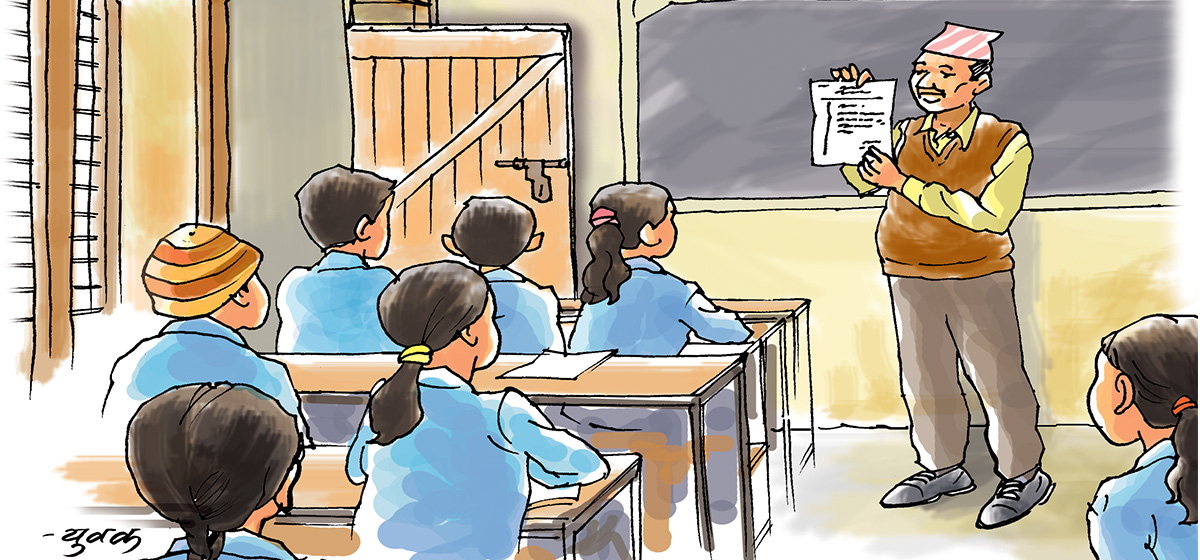
OR

24 children from ages five to 10 come to Child Education Service Center in Dhungedhara every morning at 10. For the past 12 years, Child Education Services has been dedicated to providing childcare and basic education to children belonging to families with limited financial means. Here the children of laborers, house helps, road cleaners, sand sifters, and many single parents study and play together free of cost.
The NGO, Child Education Service Center, is managed by a board of directors. Comprising of Jyoti Rajbhandari (chairperson), Kamal Raj Adhikari (vice chairperson), Guheshwori Tuladhar (secretary), Shyam Kumari Bhattarai (treasurer) and Pavitra Adhikari, Surendra Shrestha, and Anjali Manandhar as members, the board looks into all the operations of the NGO.
12 years ago Rajbhandari and Bhattarai jointly agreed to establish a school that would cater to the children of the underprivileged. “There were already too many Montessori and private schools. And while they were doing good work with giving children holistic care, they were only doing so for the children of people who could afford it,” explains Bhattarai adding that people who are capable of affording good education for their children only make up a certain portion of the population. “We wanted to help out those who were unable to give their children any form of education. Else they would grow up to be just like their parents and depend on menial work,” she says.
They initially started with 15 children. All of their parents confessed to being unable to contribute financially so their children were provided with uniforms, books and the stationeries by the organization itself. The aim was to essentially focus on child day care and give them primary level education. Children come to the school at 10 and study in their classes until 1 pm. Then they have an hour’s lunch break and continue with their classes until half past three in the afternoon. The organization also provides them lunch and the menu varies daily. Besides the essentials (Mathematics, English, Science and Nepali), they have creativity and computer lessons too. They draw pictures, make crafts, work on the five computers of the organization and have dance lessons every Friday.
When they started the founders funded the program on their own so they were unable to hire teachers and special caretakers. Since they also had to arrange for uniforms, pay the house rent, prepare meals, and distribute stationery they were stretched tight with their finances. Rajbhandari, who was a teacher by profession, taught the first few batches of students herself. It was only when a Dutch organization SVN (Stichting Veldwerk Netherlands) offered to sponsor them that they were able to bring in some teachers and better their facilities.
“At our best we can accommodate up to 30 students,” informs Bhattarai. The children are grouped into four levels according to their abilities. Those who barely recognize letters are placed in the Play Group and the others, as per their capabilities, are placed in Levels one, two or three. There’s hardly a consistency in the ages in the levels since some 10 year olds join in without a single year of formal education. Level three is the equivalent of grade three and upon finishing this level the children enroll into other schools and continue from the fourth grade. “Our students have, so far, never faced a problem upon joining new schools,” says Bhattarai. Child Education Service Center also takes responsibility of some of the student’s tuitions until grade 10.
Child Education Service Center has three teachers and a caregiver. And each student they have under their care is closely attached to the staff. Because most children come from difficult households they have had to give counseling to the children as well.
One student always came to school late and remained quiet all throughout the day. “He had a hollow look in his eyes and seemed really quiet. Upon inquiring we learnt that his mother worked as a road cleaner and that she picked up the discarded waste from the streets to make a living. The child had to take his mother her meals so by the time he made it to school it would already be 11,” explains Bhattarai.
The teachers at the school made attempts to communicate with him and while he remained silent in the beginning he eventually opened up. Today, they say, he seems very happy and amicable. At the establishment, they also have two children with Down syndrome. When they were brought in, they refused to mingle with the other children and resorted to violent tantrums. “But with time they have adjusted to the routine and get along well with the others. They have difficulties with the course work so we allow them more time and encourage the other children to help them out,” says Radha Shrestha, a teacher who also oversees the administrative aspect of the organization.
They also have some occasional foreign volunteers to help the children. The volunteers bring in season-suitable clothing for the children and help with teaching English. Some of their earlier students too visit now and then. Among their previous students Pavitra Khadka recently passed the exam to enlist into the army and the entire staff rejoiced together.
So far some 300 students have passed through the school and, for most, their lives have taken a turn for the better. But with the withdrawal of support from their primary donor SVN, Child Education Service Center is unsure of what the future holds. The founders are looking for other donors and searching for alternate means to continue their work. “All we ever wanted to do was help one and then some. The past 12 haven’t been easy and we are uncertain as to how we ought to continue. But we will try our best. After all, this work is more than worth it,” concludes Bhattarai.
You May Like This

Complete education, full health could double Nepal's GDP per capita: WB
KATHMANDU, June 7: Nepal has the potential to double its Gross Domestic Product (GDP) per capita in the long run if... Read More...

Burden of books
Different studies have shown that heavy school bags have multiple negative effects on students, including physical, psychological and economic impacts Read More...

Japan provides Rs 9.5 million for Dhanusha school
KATHMANDU, Dec 28: The Government of Japan has pledged to provide Rs 9.5 million in assistance to build the classrooms of... Read More...







Just In
- Shrestha nominated as Chairman of NCC's Advisory Council
- Take necessary measures to ensure education for all children
- Nepalgunj ICP handed over to Nepal, to come into operation from May 8
- Nepal to gift two elephants to Qatar during Emir's state visit
- NUP Chair Shrestha: Resham Chaudhary, convicted in Tikapur murder case, ineligible for party membership
- Dr Ram Kantha Makaju Shrestha: A visionary leader transforming healthcare in Nepal
- Let us present practical projects, not 'wish list': PM Dahal
- President Paudel requests Emir of Qatar to help secure release of Bipin Joshi held hostage by Hamas



_20240423174443.jpg)







Leave A Comment